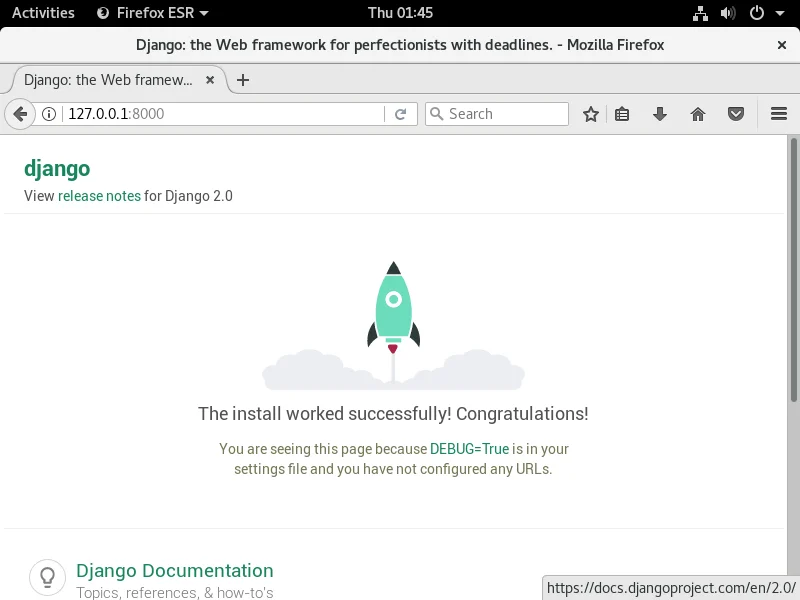1、为什么要写这个文章
由于《Django简易博客搭建教程》是基于python3.4.1+django1.7.1,在python已经进入3.6的时代,以及最重要的,django已经进入2的时代下,重新把书中的代码及时更新一下还是很有必要的。另附github:
https://github.com/DachuanZhao/learnDjango2、代码
(1)无
(2)在这里我并没有使用虚拟环境和bootstrap
pip3 install Django
apt-get install git(3)
django-admin.py startproject my_blog
cd my_blog
python3 manage.py startapp article
tree ../my_blog
#返回
#######################################################
../my_blog/
├── article
│ ├── admin.py
│ ├── apps.py
│ ├── __init__.py
│ ├── migrations
│ │ └── __init__.py
│ ├── models.py
│ ├── tests.py
│ └── views.py
├── db.sqlite3
├── manage.py
└── my_blog
├── __init__.py
├── __pycache__
│ ├── __init__.cpython-35.pyc
│ ├── settings.cpython-35.pyc
│ ├── urls.cpython-35.pyc
│ └── wsgi.cpython-35.pyc
├── settings.py
├── urls.py
└── wsgi.py
#######################################################
python3 manage.py runserver
#返回
#######################################################
Performing system checks...
System check identified no issues (0 silenced).
You have 14 unapplied migration(s). Your project may not work properly until you apply the migrations for app(s): admin, auth, contenttypes, sessions.
Run 'python manage.py migrate' to apply them.
January 25, 2018 - 09:33:22
Django version 2.0.1, using settings 'my_blog.settings'
Starting development server at http://127.0.0.1:8000/
Quit the server with CONTROL-C.
#######################################################
python3 manage.py migrate
python3 manage.py runserver
(4)创建并修改my_blog/article/models.py中的内容如下:
from django.db import models
# Create your models here.
class Article(models.Model):
title = models.CharField(max_length = 100)
category = models.CharField(max_length = 50, blank = True)
date_time = models.DateTimeField(auto_now_add = True) #the date of the blog
content = models.TextField(blank = True,null = True) #the text of the blog
def __unicode__(self):
return self.title
class Meta:#descending order by time
ordering = ['-date_time']
之后修改my_blog/my_blog/settings.py 为
INSTALLED_APPS = [
'django.contrib.admin',
'django.contrib.auth',
'django.contrib.contenttypes',
'django.contrib.sessions',
'django.contrib.messages',
'django.contrib.staticfiles',
'article'
]
并运行
python3 ./my_blog/manage.py migrate
python3 ./my_blog/manage.py makemigrations
python3 ./my_blog/manage.py migrate
python3 ./my_blog/manage.py shell
>>> from article.models import Article
>>> Article.objects.create(title = 'Hello World',category = 'Python3.5.3',content = 'let_s add a new data to the database')
<Article: Article object (1)>
>>> Article.objects.create(title = 'Learn Django Blog',category = 'Python3.5.3',content = 'create a simple blog by python3.5.3 and Django2')
<Article: Article object (2)>
>>> Article.objects.all()
<QuerySet [<Article: Article object (2)>, <Article: Article object (1)>]>
>>> Article.objects.get(id=1)
<Article: Article object (1)>
>>> first = Article.objects.get(id = 1)
>>> first.title
'Hello World'
>>> first.date_time
datetime.datetime(2018, 2, 1, 7, 57, 44, 409015, tzinfo=<UTC>)
>>> first.content
'let_s add a new data to the database'
>>> first.category
'Python3.5.3'
>>> first.content
'let_s add a new data to the database'
(5)修改my_blog/article/admin.py如下
from django.contrib import admin
# Register your models here.
from article.models import Article
admin.site.register(Article)(6)
修改my_blog/my_blog/urls.py如下:
from django.contrib import admin
from django.urls import path,re_path,include
from article.views import home,detail
urlpatterns = [
path('admin/', admin.site.urls),
re_path(r'^$',home),
re_path(r'^(?P<my_args>\d+)/$',detail,name = 'detail'),
]
修改my_blog/article/views.py如下:
from django.shortcuts import render
# Create your views here.
from django.http import HttpResponse
from article.models import Article
def home(request):
return HttpResponse("Hello World,Django")
def detail(request,my_args):
post = Article.objects.all()[int(my_args)]
my_str = ("title = %s, category = %s, date_time = %s, content = %s" \
% (post.title,post.category,post.date_time,post.content))
#return HttpResponse("You're looking at my_args %s." % my_args)
return HttpResponse(my_str)增加主机IP到my_blog/my_blog/settings.py的ALLOWED_HOSTS,以便局域网其他主机能够访问
ALLOWED_HOSTS = ['192.168.2.11'](7)+(9)markdown
安装markdown
pip3 install markdownmy_blog/article/templatetags/custom_markdown.py
# -*- coding: utf-8 -*-
import markdown
from django import template
from django.template.defaultfilters import stringfilter
from django.utils.encoding import force_text
from django.utils.safestring import mark_safe
register = template.Library()
@register.filter(is_safe=True) #register template filter
@stringfilter #set the parameter's name
def custom_markdown(value):
#extensions = ["nl2br", ]
return mark_safe(markdown.markdown(value,
extensions = ['markdown.extensions.fenced_code', 'markdown.extensions.codehilite'],
safe_mode=True,
enable_attributes=False))
# return mark_safe(markdown2.markdown(force_text(value),
# extras=["fenced-code-blocks", "cuddled-lists", "metadata", "tables", "spoiler"]))roomy_blog/templates/base.html
<! doctype html>
<html lang="en">
<head>
<meta charset="utf-8">
<meta name="viewport" content="width= device-width, initial-scale= 1.0">
<meta name="description" content="A layout example that shows off a blog page with a list of posts.">
<title> Andrew Liu Blog </title>
<link rel="stylesheet" href="http://yui.yahooapis.com/pure/0.5.0/pure-min.css">
<link rel="stylesheet" href="http://yui.yahooapis.com/pure/0.5.0/grids-responsive-min.css">
<link rel="stylesheet" href="http://picturebag.qiniudn.com/blog.css">
</head>
<body>
<div id="layout" class="pure-g">
<div class="sidebar pure-u-1 pure-u-md-1-4">
<div class="header">
<h1 class="brand-title"> Andrew Liu Blog</h1>
<h2 class="brand-tagline"> 雪忆 - Snow Memory</h2>
<nav class="nav">
<ul class="nav-list">
<li class="nav-item">
<a class="pure-button" href="https://github.com/Andrew-liu">
Github</a>
</li>
<li class="nav-item">
<a class="pure-button" href="http://weibo.com/dinosaurliu"> Weibo</a>
</li>
</ul>
</nav>
</div>
</div>
<div class="content pure-u-1 pure-u-md-3-4">
<div>
<div class="footer">
<div class="pure-menu pure-menu-horizontal pure-menu-open">
<ul>
<li><a href="http://andrewliu.tk/about/"> About Me</a>
</li>
<li><a href="http://twitter.com/yuilibrary/"> Twitter</a>
</li>
<li><a href="http://github.com/yahoo/pure/"> GitHub</a>
</li>
</ul>
</div>
</div>
</div>
</div>
</div>
</body>
</html>my_blog/templates/home.html
{% extends "base.html" %}
{% load custom_markdown %}
{% block content %}
<div class="posts">
{% for post in post_list %}
<section class="post">
<header class="post-header">
<h2 class="post-title">
<a href="{% url 'detail' id=post.id %}">{{ post.title }}</a>
</h2>
<p class="post-meta">
Time:
<a class="post-author" href="#">{{ post.date_time |date:'Y M d'}}</a>   Category:
<a class="post-category post-category-pure" href="{% url 'search_tag' tag=post.category %}">{{ post.category|title }}</a>   Tag: {% for tag in post.tag.all %}
<a class="post-category post-category-pure" href="#">{{ tag }}</a>
{% endfor %}
</p>
</header>
<div class="post-description">
<p>
{{ post.content|custom_markdown|truncatewords_html:100 }}
</p>
</div>
<a class="pure-button" href="{% url 'detail' id=post.id %}">Read More >>> </a>
</section>
{% endfor %} {% if post_list.object_list and post_list.paginator.num_pages > 1 %}
<div>
<ul class="pager">
{% if post_list.has_previous %}
<li>
<a href="?page={{ post_list.previous_page_number }}">上一页</a>
</li>
{% endif %} {% if post_list.has_next %}
<li>
<a href="?page={{ post_list.next_page_number }}">下一页</a>
</li>
{% endif %}
</ul>
</div>
{% endif %}
</div>
<!-- /.blog-post -->
{% endblock %}